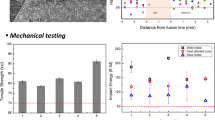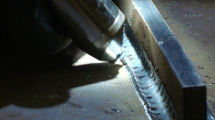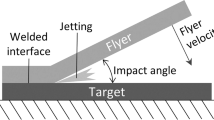Abstract
High tensile plates, SAILMA-450 high impact (HI) (yield strength, 45 kg/mm2 minimum; ultimate tensile strength, 57 kg/mm2 minimum; elongation, 19% minimum; Charpy impact energy 2.0 kg.m at −20 °C minimum) were successfully developed at the Steel Authority of India Ltd., up to 32 mm plate thickness. Since then the steel has been extensively used for the fabrication of impellers, bridges, excavators, and mining machineries, where welding is an important processing step.
The present study deals with the weldability properties of SAILMA-450 HI plates employing the gas metal arc welding process and carbon dioxide gas. Implant and elastic restraint cracking tests were conducted to assess the cold cracking resistance of the weld joint under different welding conditions. The static fatigue limit values were found to be in excess of minimum specified yield strength at higher heat input levels (9.4 and 13.0 kJ/cm), indicating adequate cold cracking resistance. The critical restraint intensities, K cr, were found to vary between 720 and 1280 kg/mm2, indicating that the process can be utilized for fabrication of structures involving moderate to low restraint intensities (200 to 1000 kg/mm2). Lamellar tear tests conducted using full thickness plates at heat input levels ranging from 10 to 27 kJ/cm showed no incidence of lamellar tear upon visual, ultrasonic, and four-section macroexamination. These tests were repeated using machined plates, such that the midthickness of the plates (segregated zone) corresponded to the heat affected zone of the weld. No cracks were observed, indicating good lamellar tear resistance of the weld joint. Optimized welding conditions were formulated based on these tests. The weld joint was subjected to extensive tests to assess the physical properties and soundness of the weld joint. The weld joint exhibited good strength (64.7 kg/mm2) and impact toughness (5.7 and 3.5 kg.m at −20 °C for weld metal and heat affected zone properties. Crack tip opening displacement (CTOD) tests carried out for parent metal, heat-affected zone, and weld metal resulted in δm values of 0.41, 0.40, and 0.34 mm, respectively, which indicates adequate resistance to cleavage fracture. It was concluded that the weld joint conforms to the requirements of SAILMA-450 HI specification and ensures a high integrity of the fabricated products.
Similar content being viewed by others
References
T. Tanaka, Controlled Rolling of Steel Plate and Strip, Int. Met. Review, (No. 4), 1981, p 185–212
G.R. Speich, L.J. Cuddy, C.R. Gordon, and A.J. DeArdo, Formation of Ferrite from Controlled Rolled Austenite, Proc. Phase Trans. in Ferrous Alloys, TMS-AIME, 1984, p 341–390
A.J. DeArdo, Ferrite Formation from Thermomechanically Processed Austenite in HSLA Steels, Proc. High Strength Low Alloy Steels, South Coast Printers, NSW, 1986, p 70
C.I. Garcia and A.J. DeArdo, Formation of Austenite in 1.5% Mn Steels, Metall. Trans. A, Vol 12, 1981, p 521
D. Webster and J.A. Woodhead, Effect of 0.03% Nb on the Ferrite Grain Size of Mild Steels, J. Iron Steel Inst., Vol 202, 1964, p 987
I. Kozasu, C. Ouchi, T. Sampei, and T. Okita, Hot Rolling as a High Temperature Thermomechanical Process, Proc. Microalloying ’75, Union Carbide Corp., New York, 1977, p 120–135
A.J. DeArdo, Accelerated Cooling: A Physical Metallurgy Perspective, Can. Metall. Q., Vol 27, 1988, p 141
L.J. Cuddy, Grain Refinement of Nb Steels by Control of Recrystallization during Hot Rolling, Metall Trans. A, Vol 15, 1984, p 87–98
D.N. Crowther and B. Mintz, Influence of Grain Size on Hot Ductility of Plain Carbon Steels, Mater. Sci. Eng., Vol 2, 1986, p 951–955
C.I. Garcia and A.J. DeArdo, Structure and Properties of ULCB Plate Steels for Heavy Section Applications, Proc. Microalloyed HSLA Steels, ASM International, 1988, p 291–300
V. Ramaswamy, R. Datta, S.K. Chaudhuri, and S. Mishra, Recent Studies in Thermomechanical Processing of Microalloyed Steels, Proc. Emerging Tech. for New Mater. and Product Mix, Materials Week (Cincinnati, OH), 1991, p 261–268
S.K. Chaudhuri, R. Datta, A.K. De, and S. Mishra, Recent Efforts in High Strength Steel Development at SAIL, Trans. IIM, Vol 49 (No. 3), 1996, p 207–216
M.J. Cieslak, Cracking Phenomena Associated with Welding, ASM Handbook, Vol 6, Welding, Brazing, and Soldering, ASM International, 1993, p 88–96
H. Garnjon, Fundamentals of Welding Metallurgy, Abington Publishing, 1991, p 156
F.R. Coe, Welding Steels without Hydrogen Cracking, Fundamentals of Welding Metallurgy, American Society for Metals, 1973, p 24–39
P.E. Reynolds, Effect of Titanium Treatment on Grain Size Control in Low Alloy Steels, Ironmaking Steelmaking, Vol 18 (No. 1), 1991, p 52–58
A.J. DeArdo, Thermomechanical Processing: Advanced Materials and Progress, Met. Progr., Vol 1, 1988, p 71–73
International Institute of Welding (IIW) document, 830–73, 1973
R. Datta, D. Mukerjee, and S. Mishra, Thermomechanical Processing of High Tensile Plates and Associated Weldability Properties, THERMEC ’97, TMS Publications, 1997, p 327–337
Author information
Authors and Affiliations
Rights and permissions
About this article
Cite this article
Datta, R., Mukerjee, D., Rohira, K.L. et al. Weldability evaluation of high tensile plates using GMAW process. J. of Materi Eng and Perform 8, 455–462 (1999). https://doi.org/10.1361/105994999770346765
Received:
Revised:
Published:
Issue Date:
DOI: https://doi.org/10.1361/105994999770346765




